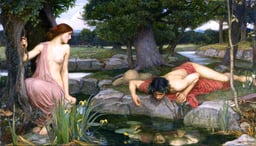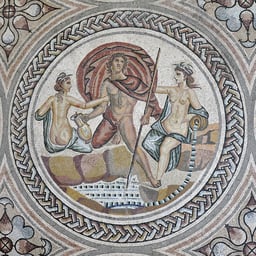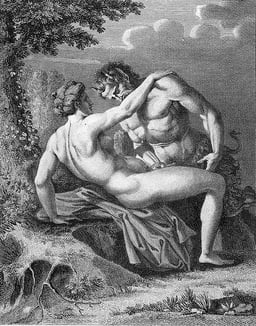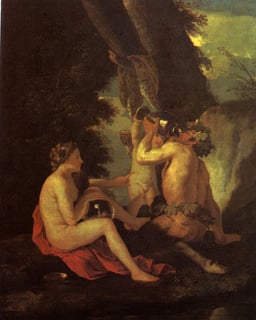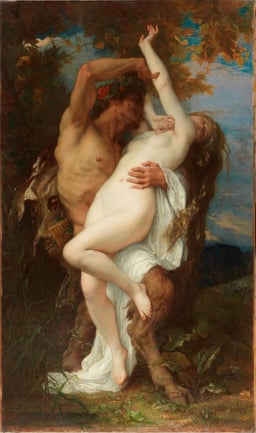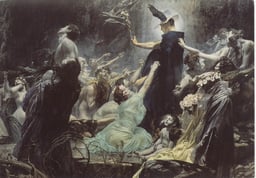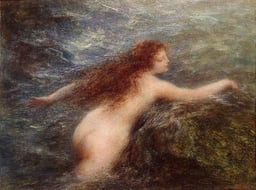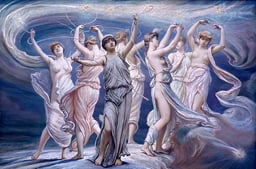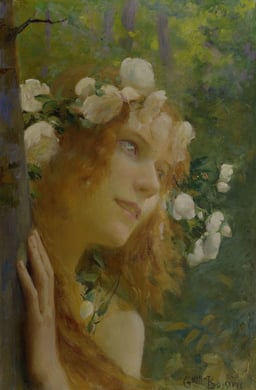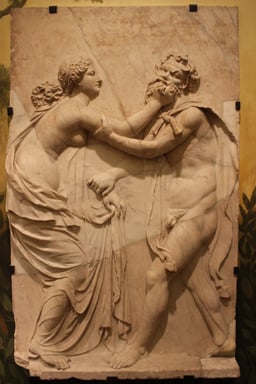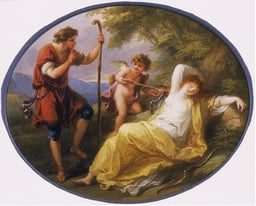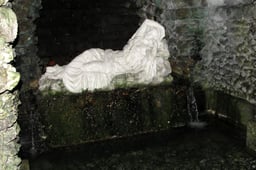Nymph
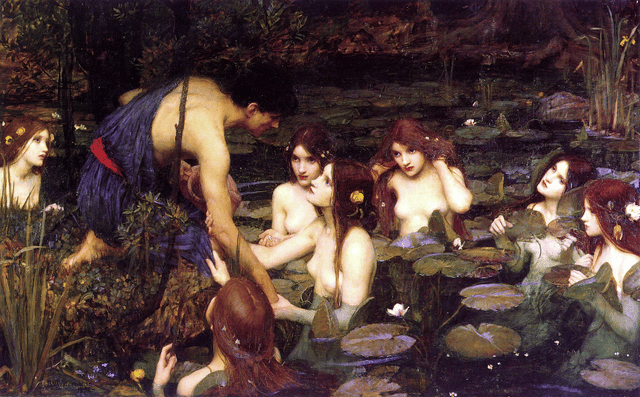
Nymph

| Grouping | Mythological |
|---|---|
| Sub grouping | Nature spirit |
| Similar creatures | Mermaid, huldra, selkie, siren |
| Mythology | Greek mythology |
| Country | Greece |
A nymph (Greek: νύμφη nýmphē, Ancient: [nýmpʰɛː] Modern: [nífi]) in Greek mythology is a supernatural being associated with many other minor female deities that are often associated with the air, seas, woods, or water, or particular locations or landforms. Different from Greek goddesses, nymphs are more generally regarded as divine spirits who animate or maintain Nature (natural forces reified and considered as a sentient being) for the environments where they live, and are usually depicted as beautiful, young, graceful maidens. They were not necessarily immortal, but lived many years before they died.[1]
They are often divided into various broad subgroups, such as the Meliae (nymphs of ash trees), the Naiads (nymphs of rivers and streams), the Nereids (nymphs of calm seas), and the Oreads (nymphs of mountains).[2]
Nymphs often feature in many classic works of art, literature, mythology and in fiction. Since medieval times, nymphs are sometimes popularly associated, or even confused, with the mythical or spiritual fairies.
| Grouping | Mythological |
|---|---|
| Sub grouping | Nature spirit |
| Similar creatures | Mermaid, huldra, selkie, siren |
| Mythology | Greek mythology |
| Country | Greece |
Etymology
The Greek word νύμφη has the primary meaning of "young woman; bride, young wife" but is not usually associated with deities in particular. Yet the etymology of the noun νύμφη remains uncertain. The Doric and Aeolic (Homeric) form is νύμφα.
Modern usage more often applies to young women at the peak of their attractiveness, contrasting with parthenos (παρθένος) "a virgin (of any age)", and generically as kore (κόρη < κόρϝα) "maiden, girl". The term is sometimes used by (human) women to address each other and remains the regular Modern Greek term for "bride".
Ancient Greek mythology
Nymphs were sometimes beloved by many and dwell in most specific areas related to the natural environment. e.g. mountainous regions and forests by springs or rivers. Other nymphs, mostly appeared in the shape of young maidens, were part of the retinue of a god, such as Dionysus, Hermes, or Pan, or a goddess, generally the huntress Artemis.[3]
The Greek nymphs were also spirits invariably bound to places, not unlike the Latin genius loci, and sometimes this produced complicated myths like cult of Arethusa to Sicily. In some of the works of the Greek-educated Latin poets, the nymphs gradually absorbed into their ranks the indigenous Italian divinities of springs and streams (Juturna, Egeria, Carmentis, Fontus), while the Lymphae (originally Lumpae), Italian water-goddesses, owing to the accidental similarity of their names, could be identified with the Greek Nymphae. The classical mythologies of the Roman poets were unlikely to have affected the rites and cults of individual nymphs venerated by country people in the springs and clefts of Latium. Among the Roman literate class, their sphere of influence was restricted, and they appear almost exclusively as divinities of the watery element.
Greek folk religion
The ancient Greek belief in nymphs survived in many parts of the country into the early years of the twentieth century, when they were usually known as "nereids".[4] Often nymphs tended to frequent areas distant from humans but could be encountered by lone travelers outside the village, where their music might be heard, and the traveler could spy on their dancing or bathing in a stream or pool, either during the noon heat or in the middle of the night. They might appear in a whirlwind. Such encounters could be dangerous, bringing dumbness, besotted infatuation, madness or stroke to the unfortunate human. When parents believed their child to be nereid-struck, they would pray to Saint Artemidos.[5][6]
Nymphs and fairies
Nymphs often feature or are depicted in many classic works across art, literature, mythology and in fiction. They are often associated with the medieval romances or Renaissance literature of the elusive mythical or spiritual fairies or elves.[7] Fairies are believed to have mixed openly with the classical nymphs and satyrs[8], or sometimes even replacing the roles of the classical nymphs.
Modern reception
Sleeping nymph
A motif that entered European art during the Renaissance was the idea of a statue of a nymph sleeping in a grotto or spring.[9][10][11] This motif supposedly came from an Italian report of a Roman sculpture of a nymph at a fountain above the River Danube.[12] The report, and an accompanying poem supposedly on the fountain describing the sleeping nymph, are now generally concluded to be a fifteenth-century forgery, but the motif proved influential among artists and landscape gardeners for several centuries after, with copies seen at neoclassical gardens such as the grotto at Stourhead.[13][14][15]
List
All the names for various classes of nymphs have plural feminine adjectives, most agreeing with the substantive numbers and groups of nymphai. There is no single adopted classification that could be seen as canonical and exhaustive.[16] Some classes of nymphs tend to overlap, which complicates the task of precise classification. e.g. Dryads and hamadryads as nymphs of trees generally, meliai as nymphs of ash trees, and naiads as nymphs of water, but no others specifically.[16]
By type of dwelling
The following is not the authentic Greek classification, but is intended simply as a guide:
| Type / Group / Individuals | Location | Relations and Notes |
|---|---|---|
| Celestial nymphs | ||
| Aurae (breezes) | also called Aetae or Pnoae | |
| Asteriae (stars) | mainly comprising the Atlantides (daughters of Atlas) | |
| Far West | nymphs of the sunset, the West, and the evening; daughters of Atlas; also had attributes of the Hamadryads |
| • Aegle | ||
| • Arethusa | ||
| • Erytheia (or Eratheis) | ||
| • Hesperia (or Hispereia) | ||
| ||
| daughters of Atlas and Pleione; constellation; also were classed as Oreads | |
| • Maia | partner of Zeus and mother of Hermes | |
| • Electra | ||
| • Taygete | ||
| • Alcyone | ||
| • Celaeno | ||
| • Asterope | ||
| • Merope | ||
| Nephele (clouds) | ||
| Land nymphs | ||
| Alseides (groves) | ||
| Auloniades (valley pastures, glens) | ||
| Leimakides or Leimonides (meadows) | ||
| Napaeae (dells) | ||
| Oreads (mountains, grottoes), also Orodemniades | ||
| Wood and plant nymphs | ||
| Anthousai (flowers) | ||
| Dryades (trees) | ||
| Hamadryades or Hadryades | ||
| ||
| other name variants include Meliades, Maliades and Hamameliades; same as these are also the Boucolai (Pastoral Nymphs) | |
| ||
| ||
| Hyleoroi (watchers of woods) | ||
| Water nymphs (Hydriades or Ephydriades) | ||
| Haliae (sea and seashores) | ||
| ||
| Naiads or Naides (fresh water) | ||
| ||
| ||
| ||
| ||
| ||
| • Tágides (Tagus River) | ||
| Oceanids | daughters of Oceanus and Tethys, any water, usually salty. see List of Oceanids | |
| Underworld nymphs | ||
| Cocytiae | daughters of the river god Cocytus | |
| Lampades | torch bearers in the retinue of Hecate | |
| Underworld nymphs: | ||
| • Orphne | is a representation of the darkness of the river Styx, the river of hatred, but is not to be confused with the goddess Styx-herself, but she is associated with both Styx and Nyx. She is the consort of Acheron, (the god of the river in Hades), and the mother of Ascalaphus, (the orchardist of Hades). | |
| • Leuce (white poplar tree) | lover of Hades | |
| • Minthe (mint) | lover of Hades, rival of Persephone | |
| • Melinoe | Orphic nymph, daughter of Persephone and "Zeus disguised as Pluto".[17] Her name is a possible epithet of Hecate. | |
| Other nymphs | ||
| Hecaterides (rustic dance) | sisters of the Dactyls, mothers of the Oreads and the Satyrs | |
| Kabeirides | sisters of the Kabeiroi | |
| Maenads or Bacchai or Bacchantes | frenzied nymphs in the retinue of Dionysus | |
| ||
| ||
| ||
| ||
| Melissae (honey bees) | likely a subgroup of Oreades or Epimelides | |
| The Muses (memory, knowledge, art) | ||
| Themeides | daughters of Zeus and Themis, prophets and keepers of certain divine artifacts | |
By location
The following is a list of groups of nymphs associated with this or that particular location. Nymphs in such groupings could belong to any of the classes mentioned above (Naiades, Oreades, and so on).
| Groups and Individuals | Location | Relations and Notes |
|---|---|---|
| Aeaean Nymphs | Aeaea Island | handmaidens of Circe |
| Aegaeides | Aegaeus River on the island of Scheria | |
| Aesepides | Aesepus River in Anatolia | |
| • Abarbarea | ||
| Acheloides | Achelous River | |
| • Callirhoe, second wife of Alcmaeon | ||
| Acmenes | Stadium in Olympia, Elis | |
| Amnisiades | Amnisos River on the island of Crete | entered the retinue of Artemis |
| Anigrides | Anigros River in Elis | believed to cure skin diseases |
| Asopides | Asopus River in Sicyonia and Boeotia | |
| • Aegina | Island of Aegina | mother of Menoetius by Actor, and Aeacus by Zeus |
| • Asopis | ||
| • Chalcis | Chalcis, Euboea | regarded as the mother of the Curetes and Corybantes; perhaps the same as Combe and Euboea below |
| • Cleone | Cleonae, Argos | |
| • Combe | Island of Euboea | consort of Socus and mother by him of the seven Corybantes |
| • Corcyra | Island of Corcyra | mother of Phaiax by Poseidon |
| • Euboea | Island of Euboea | abducted by Poseidon |
| • Gargaphia or Plataia or Oeroe | Plataea, Boeotia | carried off by Zeus |
| • Harmonia | a nymph of the Akmonian Wood, near Themiscyra | mother of the Amazons by Ares[18][19] |
| • Harpina | Pisa, Elis | mother of Oenomaus by Ares |
| • Ismene | Ismenian spring of Thebes, Boeotia | wife of Argus, eponymous king of Argus and thus, mother of Argus Panoptes and Iasus. |
| • Nemea | Nemea, Argolis | others called her the daughter of Zeus and Selene |
| • Ornea | Ornia, Sicyon | |
| • Peirene | Corinth | others called her father to be Oebalus or Achelous by Poseidon she became the mother of Lecheas and Cenchrias |
| • Salamis | Island of Salamis | mother of Cychreus by Poseidon |
| • Sinope | Sinope, Anatolia | mother of Syrus by Apollo |
| • Tanagra | Tanagra, Boeotia | mother of Leucippus and Ephippus by Poemander |
| • Thebe | Thebes, Boeotia | wife of Zethus and also said to have consorted with Zeus |
| • Themis | Arcadia | She had a son with Hermes, called Evander. Her son was the founder of the Pallantium. Pallantium became one of the cities that was merged later into the ancient Rome. Romans called her, Carmenta.[20] |
| • Thespeia | Thespia, Boeotia | abducted by Apollo |
| Astakides | Lake Astacus, Bithynia | appeared in the myth of Nicaea |
| • Nicaea | ||
| Asterionides | Asterion River, Argos | daughters of the river god Asterion; nurses of the infant goddess Hera |
| • Acraea | ditto | |
| • Euboea | ditto | |
| • Prosymna | ditto | |
| Carian Naiades (Caria) | ||
| • Salmacis | ||
| Nymphs of Ceos | ||
| Corycian Nymphs (Corycian Cave) | Corycian cave, Delphi, Phocis | daughters of the river god Pleistos |
| • Kleodora (or Cleodora) | Mt. Parnassus, Phocis | mother of Parnassus by Poseidon |
| • Corycia | Corycian cave, Delphi, Phocis | mother of Lycoreus by Apollo |
| • Daphnis | ||
| • Melaina | ditto | mother of Delphos by Apollo |
| Cydnides | River Cydnus in Cilicia | |
| Cyrenaean Nymphs | City of Cyrene, Libya | |
| Cypriae Nymphs | Island of Cyprus | |
| Cyrtonian Nymphs | Town of Cyrtone, Boeotia | Κυρτωνιαι |
| Deliades | Island of Delos | daughters of Inopus, god of the river Inopus |
| Dodonides | Oracle at Dodona | |
| Erasinides | Erasinos River, Argos | daughters of the river god Erasinos; attendants of the goddess Britomartis. |
| • Anchiroe | ditto | |
| • Byze | ditto | |
| • Maera | ditto | |
| • Melite | ditto | |
| Nymphs of the river Granicus | ||
| • Alexirhoe | ||
| • Pegasis | ||
| Heliades | River Eridanos | daughters of Helios who were changed into trees |
| Himeriai Naiades | Local springs at the town of Himera, Sicily | |
| Hydaspides | Hydaspers River, India | nurses of infant Zagreus |
| Idaean Nymphs | Mount Ida | nurses of infant Zeus |
| • Ida | ||
| • Adrasteia | ||
| Inachides | Inachos River, Argos | daughters of the river god Inachus |
| • Io | ditto | mother of Epaphus by Zeus |
| • Amymone | ditto | |
| • Philodice | ditto | wife of Leucippus of Messenia by whom she became the mother of Hilaeira, Phoebe and possibly Arsinoe |
| • Messeis | ditto | |
| • Hyperia | ditto | |
| • Mycene | ditto | wife of Arestor and by him probably the mother of Argus Panoptes; eponym of Mycenae |
| Ionides | Kytheros River in Elis | daughters of the river god Cytherus |
| • Calliphaea | ditto | |
| • Iasis | ditto | |
| • Pegaea | ditto | |
| • Synallaxis | ditto | |
| Ithacian Nymphs | Local springs and caves on the island of Ithaca | |
| Ladonides | Ladon River | |
| Lamides or Lamusides | Lamos River in Cilicia | possible nurses of infant Dionysus |
| Leibethrides | Mounts Helicon and Leibethrios in Boeotia; or Mount Leibethros in Thrace) | |
| • Libethrias | ||
| • Petra | ||
| Lelegeides | Lycia, Anatolia | |
| Lycaean Nymphs | Mount Lycaeus | nurses of infant Zeus, perhaps a subgroup of the Oceanides |
| Melian Nymphs | Island of Melos | transformed into frogs by Zeus; not to be confused with the Meliae (ash tree nymphs |
| Mycalessides | Mount Mycale in Caria, Anatolia | |
| Mysian Nymphs | Spring of Pegai near Lake Askanios in Bithynia | who abducted Hylas |
| • Euneica | ||
| • Malis | ||
| • Nycheia | ||
| Naxian Nymphs | Mount Drios on the island of Naxos | nurses of infant Dionysus; were syncretized with the Hyades |
| • Cleide | ||
| • Coronis | ||
| • Philia | ||
| Neaerides | Thrinacia Island | daughters of Helios and Neaera, watched over Helios' cattle |
| Nymphaeides | Nymphaeus River in Paphlagonia | |
| Nysiads | Mount Nysa | nurses of infant Dionysos, identified with Hyades |
| Ogygian Nymphs | Island of Ogygia | four handmaidens of Calypso |
| Ortygian Nymphs | Local springs of Syracuse, Sicily | named for the island of Ortygia |
| Othreides | Mount Othrys | a local group of Hamadryads |
| Pactolides | Pactolus River | |
| • Euryanassa, wife of Tantalus | ||
| Pelionides | Mount Pelion | nurses of the Centaurs |
| Phaethonides | a synonym for the Heliades | |
| Phaseides | Phasis River | |
| Rhyndacides | Rhyndacus River in Mysia | |
| Sithnides | Fountain at the town of Megara | |
| Spercheides | River Spercheios | one of them, Diopatra, was loved by Poseidon and the others were changed by him into trees |
| Sphragitides, or Cithaeronides | Mount Cithaeron | |
| Tagids, Tajids, Thaejids or Thaegids | River Tagus in Portugal and Spain | |
| Thessalides | Peneus River in Thessaly | |
| Thriae | Mount Parnassos | prophets and nurses of Apollo |
| Trojan Nymphs | Local springs of Troy |
Others
The following is a selection of names of the nymphs whose class was not specified in the source texts. For lists of Naiads, Oceanids, Dryades etc. see respective articles.
| Names | Location | Relations and Notes |
|---|---|---|
| Alphesiboea | India | loved by Dionysus |
| Aora | eponym of the town Aoros in Crete[21] | |
| Areia | Crete | daughter of Cleochus and mother of Miletus by Apollo[22] |
| Astyoche | one of the Danaïdes, and the mother of Chrysippus by Pelops.[23] | |
| Axioche or Danais | mother of Chrysippus by Pelops | |
| Brettia | eponym of Abrettene, Mysia[24] | |
| Brisa | brought up the god Dionysus[25] | |
| Calybe | Troy | mother of Bucolion, Laomedon' |
| Chalcea | mother of Olympus by Zeus[26] | |
| Chania | a lover of Heracles | |
| Chariclo | mother of Tiresias by Everes | |
| Charidia | mother of Alchanus by Zeus[26] | |
| Chryse | Lemnos | fell in love with Philoctetes[27] |
| Cirrha | eponym of Cirrha in Phocis[28] | |
| Clymene | mother of Tlesimenes by Parthenopaeus | |
| Cretheis | briefly mentioned in Suda[29] | |
| Crimisa | eponym of a city in Italy[30] | |
| Deiopea | one of Hera's nymphs who was promised to Aeolus | |
| Dodone | Dodona | eponym of Dodona |
| Echemeia | spelled "Ethemea" by Hyginus, consort of Merops | |
| Eidothea | Mt. Othrys | mother by Eusiros of Cerambus[31] |
| Eunoe | possible mother of Hecuba by Dymas | |
| Eunoste | Boeotia (possibly) | nurse of Eunostus |
| Euryte | Athens | mother of Halirrhothius by Poseidon[32] |
| Hegetoria | Rhodes | consort of Ochimus |
| Himalia | mother of Cronius, Spartaios, and Cytos by Zeus | |
| Hyale | belongs to the train of Artemis | |
| Hyllis | Argos | possible eponym of the tribe Hylleis and the city Hylle[33] |
| Idaea | Crete | mother of Cres[34] and Asterion[26] by Zeus |
| Idaea | Mt. Ida, Troad | mother of Teucer by Scamander |
| Ithome | Messenia | one of the nurses of Zeus |
| Laodice | Argolis (possibly) | mother of Apis by Phoroneus |
| Leucophryne | Magnesia (possibly) | priestess of Artemis Leucophryne |
| Ligeia | ||
| Linos | mother of Pelops by Atlas in some accounts[35] | |
| Lotis | pursued by Priapus and was changed into a tree that bears her name | |
| Ma | nymph in the suite of Rhea who nursed Zeus | |
| Melanippe | Attica (possibly) | married Itonus, son of Amphictyon.[36] |
| Melissa | discovered and taught the use of honey; nurse of Zeus | |
| Mendeis | consort of Sithon | |
| Menodice | daughter of Orion and mother of Hylas by Theiodamas | |
| Myrmex | Attica | beloved companion of Athena whom she turned into an ant[37] |
| Nacole | eponym of Nacoleia in Phrygia[38] | |
| Neaera | Thrinacia | mother of Lampetia and Phaethusa by Helios |
| Neaera | mother of Aegle by Zeus[39] | |
| Neaera | Lydia | mother of Dresaeus by Theiodamas[40] |
| Nymphe | Samothrace | mother of Saon by Zeus |
| Oeneis | mother of Pan by Hermes | |
| Oinoie | mother of Sicinus by Thoas | |
| Olbia | Bithynia | mother of Astacus by Poseidon |
| Paphia | possibly the mother of Cinyras by Eurymedon | |
| Pareia | mother of four sons by Minos | |
| Polydora | one of the Danaïdes | |
| Pyronia | mother of Iasion by Minos | |
| Psalacantha | changed into a plant by Dionysus | |
| Rhene | Mount Cyllene | consorted with both Hermes and Oileus |
| Semestra | nurse of Keroessa | |
| Sinoe | Arcadia | nurse of Pan |
| Teledice | a consort of Phoroneus | |
| Thalia | Sicily (probably) | mother of the Palici by Zeus |
| Thisbe | Boeotia | eponym of the town of Thisbe |
| Tithorea | Mt. Parnassus | eponym of the town of Tithorea (previously called Neon) |
In non-Greek tales influenced by Greek mythology
Sabrina (the river Severn)
